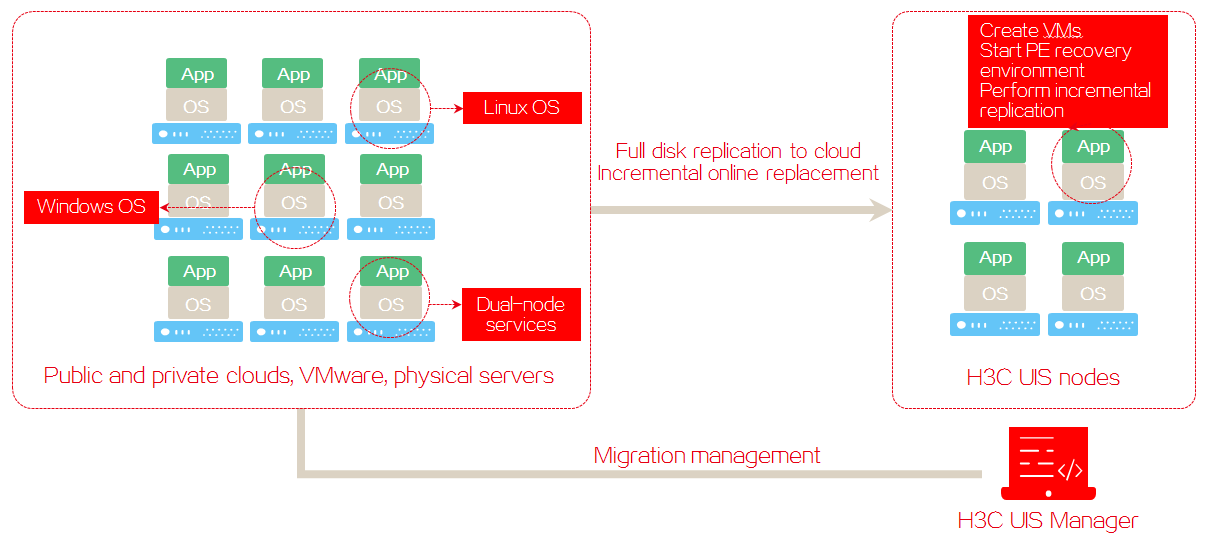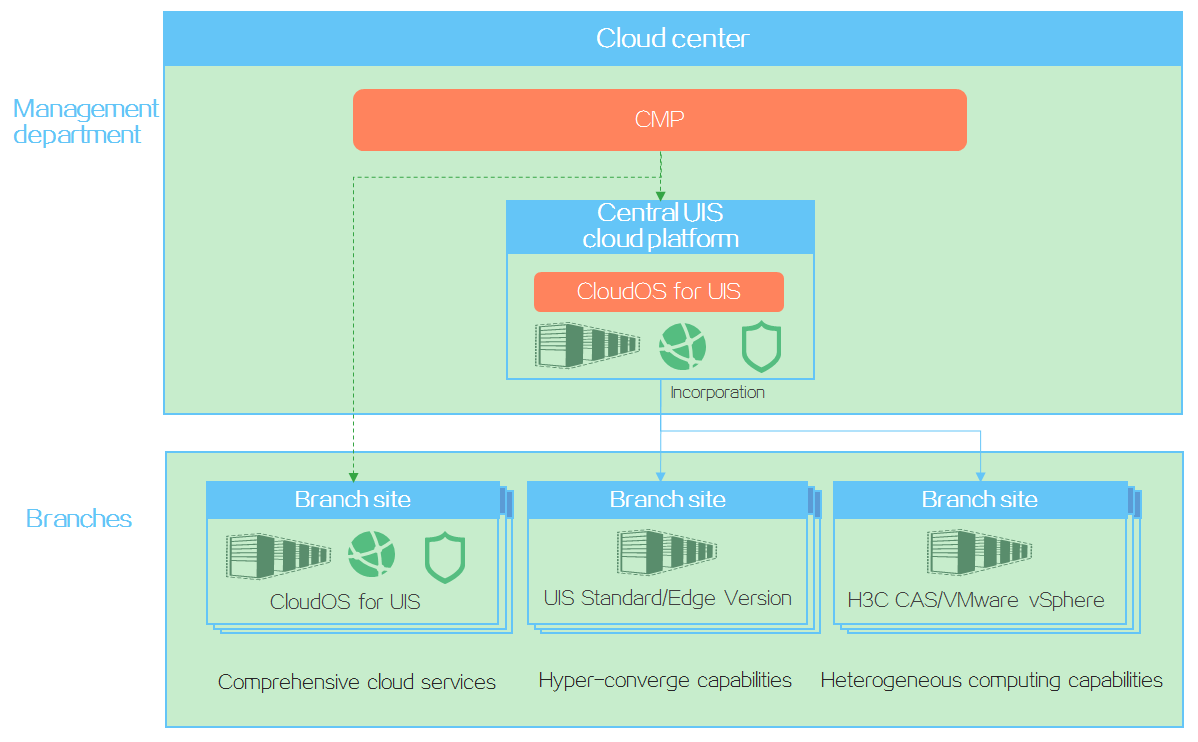Application scenarios
Hyper-converged virtualization scenarios
The H3C UIS HCI software provides the server virtualization capabilities to implement virtualized data centers and improve hardware resource utilization. In addition, it implements full virtualization of the IT infrastructure by integrating compute, storage, and network resources into an x86 server, effectively addressing the issue of increasing IT resources and saving customers' purchase and maintenance costs, as well as power supply, cooling, and relevant expenses on IT equipment rooms.
VDI scenarios
UIS is the best choice for customers working with governments and departments of law enforcement and taxation who have a strong demand for cloud desktop to reduce the difficulty and cost of IT management. Customers can implement cloud desktop with fixed hardware configuration and do not need additional computing and storage devices. UIS achieves modular deployment and provides linear capacity expansion. At the same time, the UIS hyper-converged distributed storage can implement high reliability and high performance with multiple copies, ensuring user experience of the cloud desktop and high data reliability.
Lower-latency, all-flash scenarios
UIS is applicable to the all-flash scenarios with the following advantages:
Uses high-performance storage media such as SSD and NVMe for data caching or hot data tiering to improve overall storage performance.
Uses the advanced Kernel-bypass architecture that avoids a large number of calls from the operating system and shortens the I/O path.
Uses the polling technology to lock a small number of CPU cores, maximizing the processing capabilities of CPU cores and reducing the overhead of scheduling among CPU cores.
Uses the data localization technology to save data copies to the nodes closest to the relevant service in virtualization scenarios, reducing network access overhead.
Unified storage scenarios
UIS provides various types of storage services including block-level storage (iSCSI), OSS object storage (S3/Swift), and NAS file storage (NFS/CIFS). By managing storage services through unified web interfaces, UIS is applicable to the unified storage scenarios.
Hyper-converged service migration scenarios
UIS Manager provides the heterogeneous migration service to perform P2V and V2V migration, and supports heterogeneous virtualization and hardware platforms. Service migration is available starting from the UIS standard version. With the Agent client service installed on the physical or virtual machine to be migrated at the source end, data can be migrated by using the block-level migration technology to the target machine in real time. The migration is performed at the operating system level. UIS supports smooth data migration from heterogeneous virtualization, hardware platforms, public clouds, and private clouds.
Figure-1 Heterogeneous migration
Hyper-converged disaster recovery and backup scenarios
UIS Manager uses the heterogeneous disaster recovery service to provide unified data and service protection solutions for private cloud, public cloud, hybrid cloud, and various types of IT systems on and off the cloud. In addition, UIS Manager provides cloud backup services to achieve VM-level full, incremental, and differential backup capabilities without using an agent, and implement file/database data backup management.
UIS has the following advantages for disaster recovery and backup services:
Ready for use upon delivery without requiring third-party tools.
The disaster recovery and backup solution features steamlined server resources, reduced number of servers, and integrated IT infrastructure resources in a data center. It is a solution of lower cost and higher service level for business departments.
Disaster recovery and backup capabilities are integrated with cloud resources and management systems, addressing compatibility issues and reducing optimization complexity after purchase.
ROBO scenarios
Traditional cloud computing scenarios typically adopt an I/O-intensive, highly centralized cloud data center architecture that deploys computing in one or more centers. As enterprises create more branches at different sites to meet their business needs, the traditional architecture cannot meet the demand of branch offices for low latency and high bandwidth. Additionally, branch offices require limited IT infrastructure facilities that cannot support operating a data center. UIS Manager provides the ROBO scenarios to address these issues.
The ROBO solution sets up a two-level topology with a highly centralized cloud data center and small-scale branch sites accessing the data center. Based on the UIS product advantages, the ROBO solution integrates the computing, storage, and network requirements of branch offices into a hyper-converged product. The vendor connects the UIS product to the data center site upon delivery. Product maintenance can be performed from the data center site. Branch sites only need to perform simple operations such as power-on. Compared with traditional solutions, the ROBO solution has the following characteristics:
Ready for use upon delivery. The ROBO solution fully utilizes the advantages of the overall H3C product lines, integrating firewalls, routers, switches, servers, and storage devices without additional purchases.
Rapid deployment. Graphical tools using wizards allows for automatic preinstallation at branch sites. The deployment and data center connection can be complete by requiring a minimum of on-site configuration, saving 80% of the total deployment time and 75% of IT workforce.
Unattended O&M. The management platform deployed at the central site can monitor and manage branch sites. The central site performs remote maintenance and upgrade without requiring specialized IT personnel at the branch sites. Branch users only need to perform basic operations such as powering on and off and replacing hard drives. Administrators can monitor the site status and alarms on a PC or smartphone. The central site can fix faults at branch sites and perform intelligent prediction for faulty disks, storage performance, and storage capacity.
Software-defined branch sites. The central site can create application installation packages to bulk distribute service applications to branch sites.
Remote upgrade. With a specific preinstalled program at a branch site, the central site can automatically discover and upgrade the branch site without requiring manual intervention.
Branch site data backup. Data at branch sites can be backed up to UISCloud at the central site to prevent various data risks.
UIS consumes a minimum of resources as compared with server deployment in a traditional equipment room. Deploying UIS can save 70% of the equipment room area, 26% of device power consumption, and 93% of cables. In addition, deploying UIS reduces deployment complexity and increases 30% of the utilization rate of virtualization resources.
Figure-2 Branch site management by using the ROBO solution
Branch sites with only computing and storage requirements only need to deploy the UIS standard or edge version.
Traditional virtualization platforms (such as CAS and VMware) that have been deployed at branch sites can be managed by CloudOS for UIS at the central site.
CloudOS for UIS can be deployed for large-scale branch sites with cloud service requirements for cloud edge autonomy.
CloudOS for UIS supports unified resource management and pushes service images to the edge for flexible service changes.

